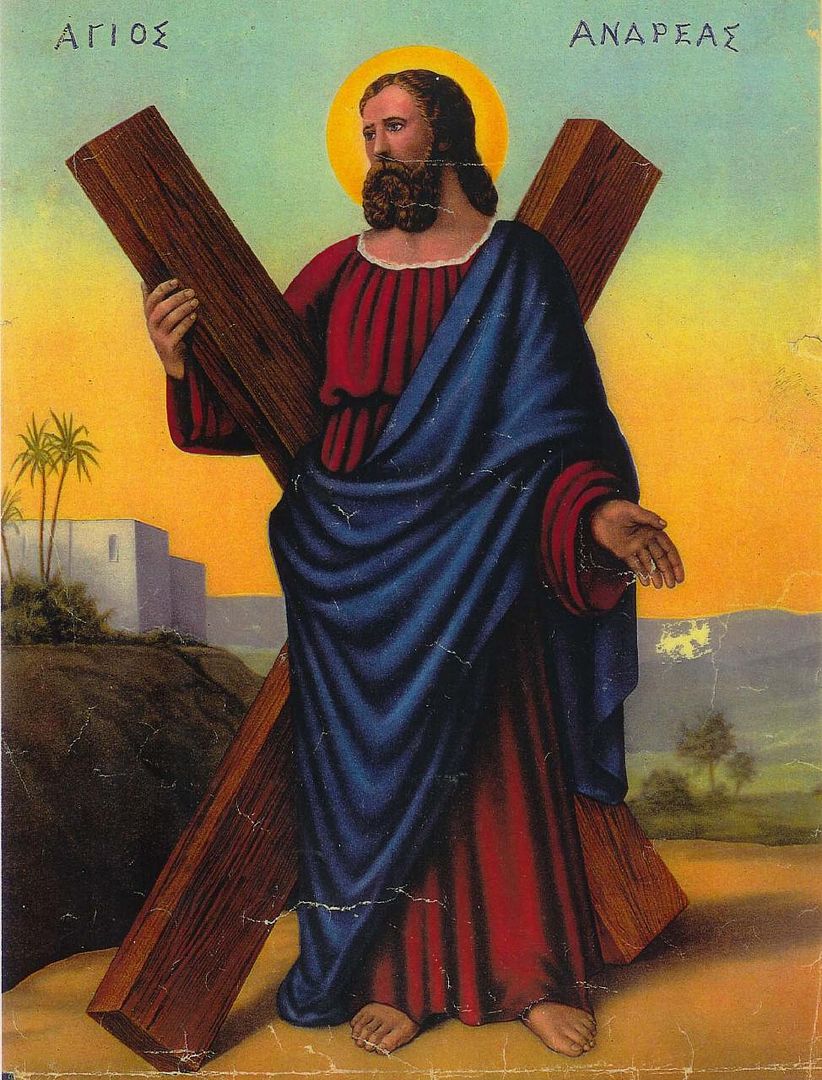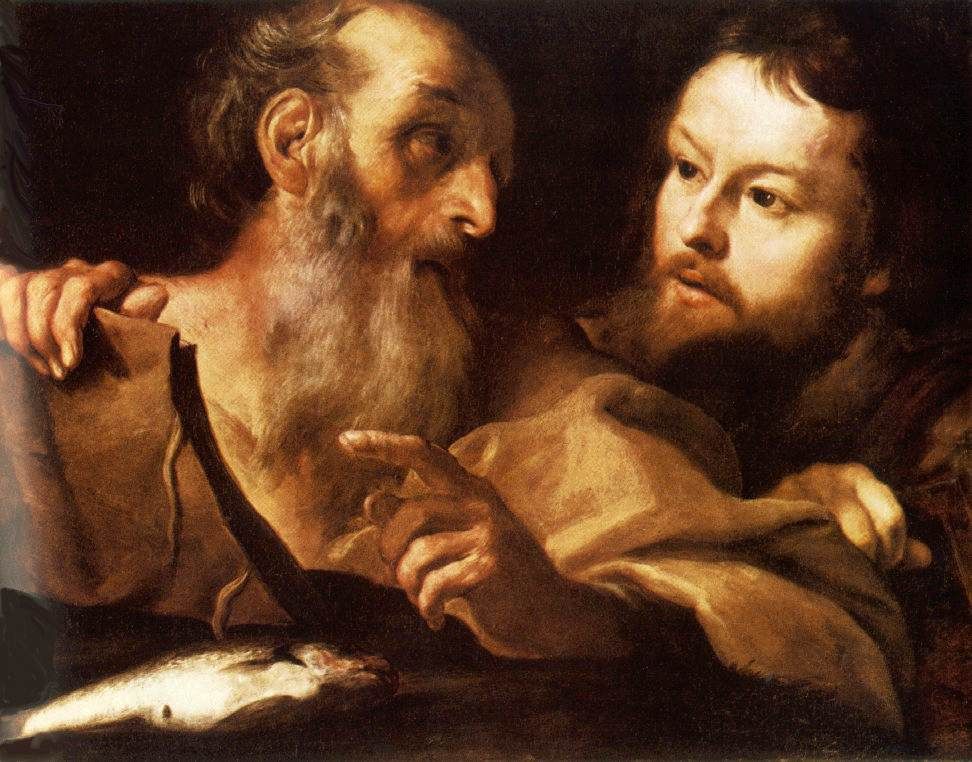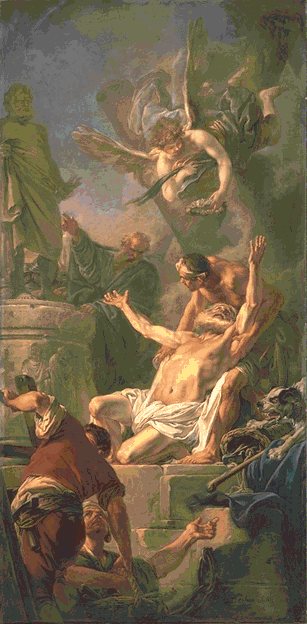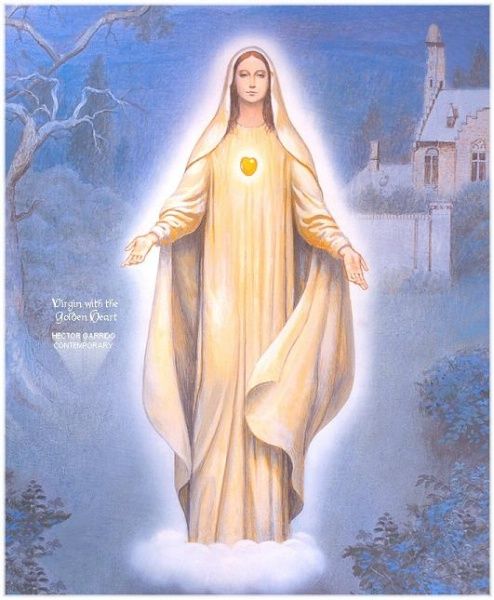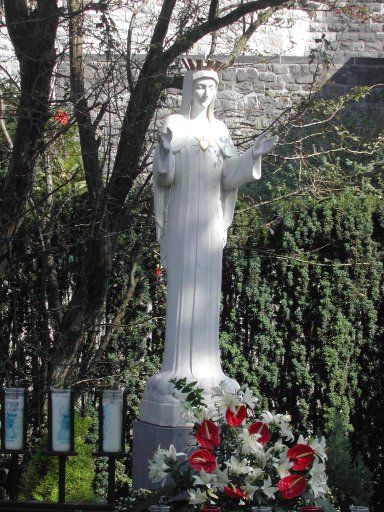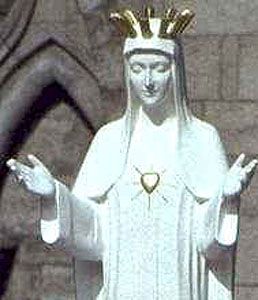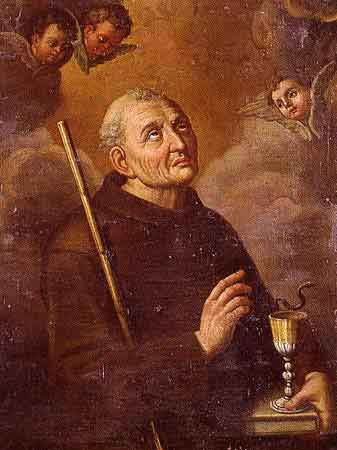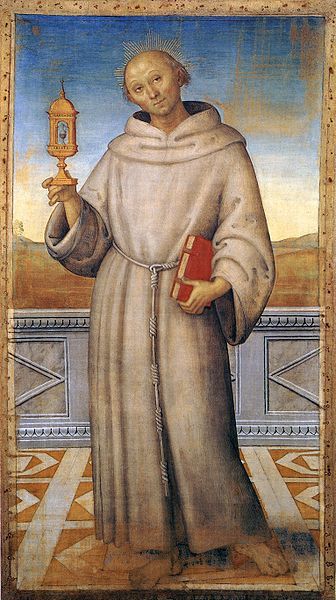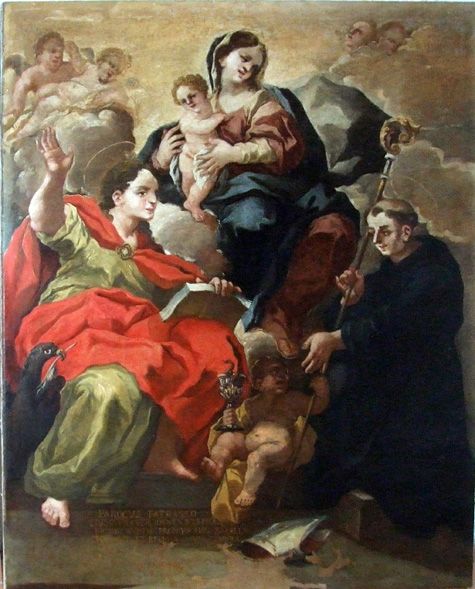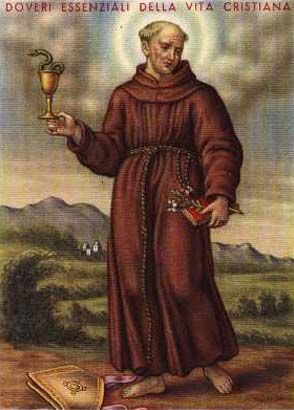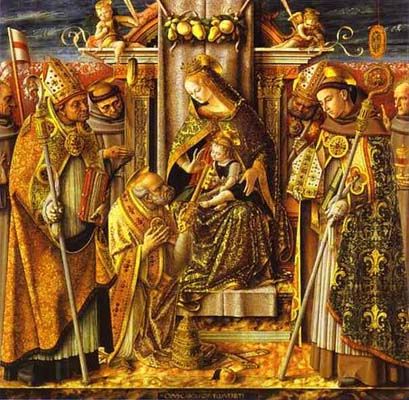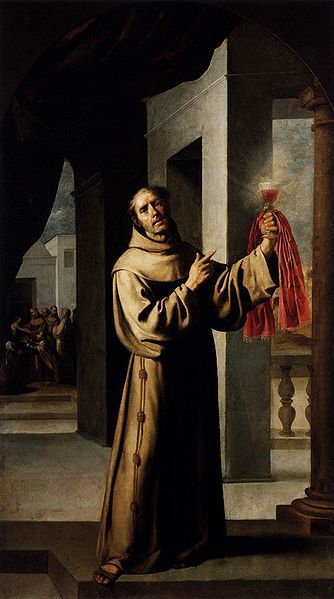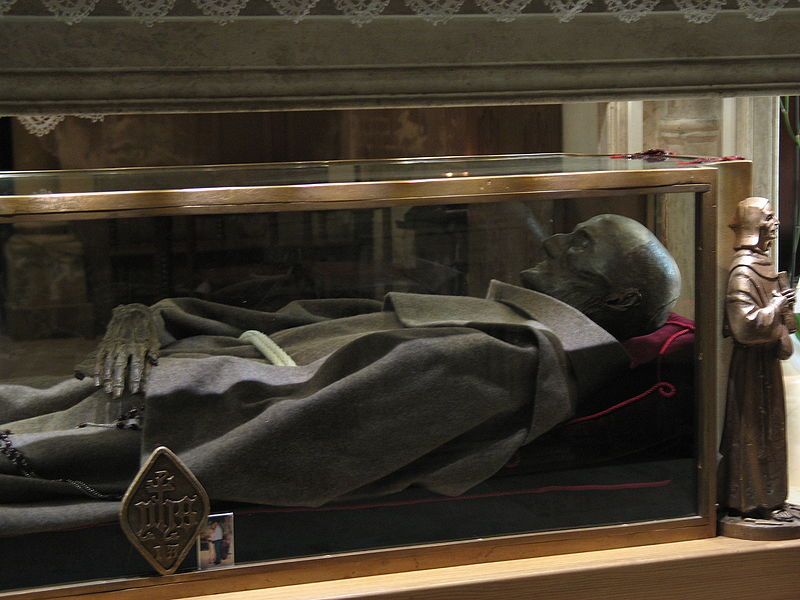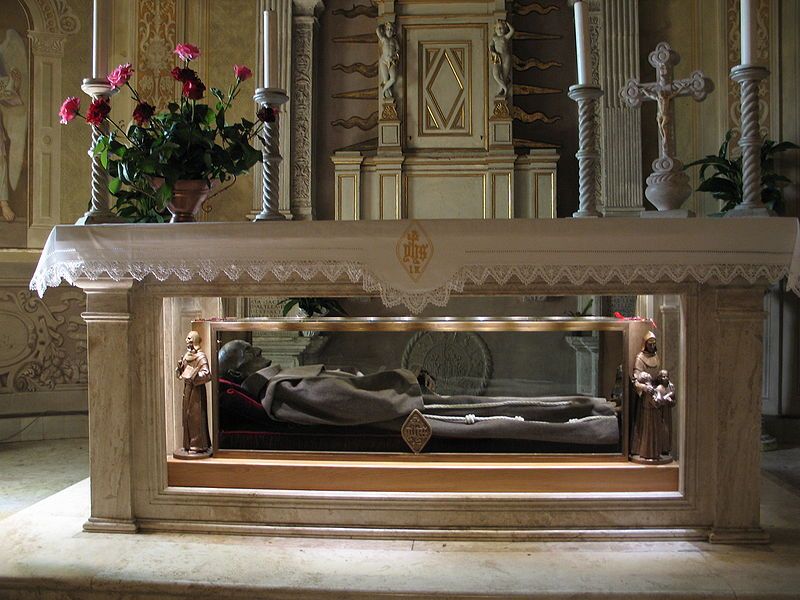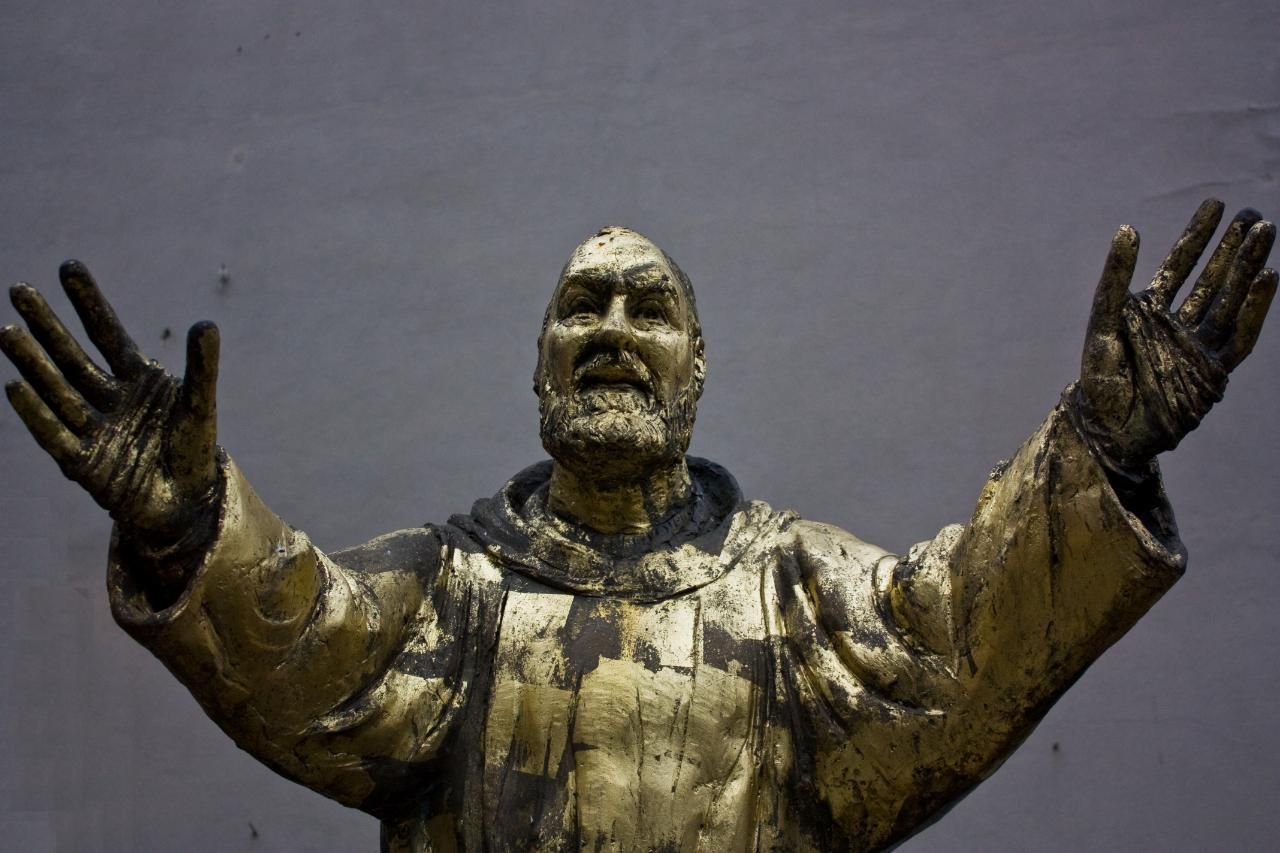Today, November 30, we celebrate the feast day of Saint Andrew (died 60 AD), the Lord’s first apostle, martyr for the faith, and patron saint of Scotland. While John is not featured prominently in the New Testament (although is always listed within the first four disciples, signifying importance), we realize that his faith brought not only his brother, Simon Peter, to follow Jesus, but also many others. Throughout his life, Andrew testified to the love and divinity of Christ, earning himself the martyr’s crown.
Below, the text of the General Audience delivered by Pope Benedict XVI on June 14, 2006, entitled, "Andrew, the Protoclete."
Why pray the Rosary every day for a year?
Each time the Blessed Virgin has appeared-- whether it be to Saint Bernadette Soubirous at Lourdes; to Lucia, Jacinta, and Francisco at Fatima; or to Mariette Beco at Banneux-- she has asserted the importance, saving grace, and power of praying the Holy Rosary on a daily basis. Based upon her words, the Rosary is penance and conversion for sinners, a pathway to peace, an end to war, and a powerful act of faith in Jesus Christ. Pope Paul VI presented the Rosary as a powerful means to reach Christ "not merely with Mary but indeed, insofar as this is possible to us, in the same way as Mary, who is certainly the one who thought about Him more than anyone else has ever done."
To show us how this is done, perhaps no one has been more eloquent than the great Cardinal Newman, who wrote: "The great power of the Rosary consists in the fact that it translates the Creed into Prayer. Of course, the Creed is already in a certain sense a prayer and a great act of homage towards God, but the Rosary brings us to meditate again on the great truth of His life and death, and brings this truth close to our hearts. Even Christians, although they know God, usually fear rather than love Him. The strength of the Rosary lies in the particular manner in which it considers these mysteries, since all our thinking about Christ is intertwined with the thought of His Mother, in the relations between Mother and Son; the Holy Family is presented to us, the home in which God lived His infinite love."
As Mary said at Fatima, "Jesus wants to use you to make Me known and loved. He wishes to establish the devotion to My Immaculate Heart throughout the world. I promise salvation to whoever embraces it; these souls will be dear to God, like flowers put by Me to adorn his throne."
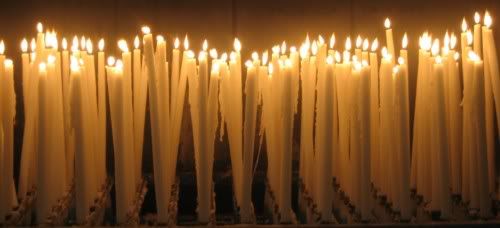
Today, November 30, we celebrate the feast day of Saint Andrew (died 60 AD), the Lord’s first apostle, martyr for the faith, and patron saint of Scotland. While John is not featured prominently in the New Testament (although is always listed within the first four disciples, signifying importance), we realize that his faith brought not only his brother, Simon Peter, to follow Jesus, but also many others. Throughout his life, Andrew testified to the love and divinity of Christ, earning himself the martyr’s crown.
Andrew, like his brother Simon Peter, was a fisherman. Early in his life, he became a disciple of Saint John the Baptist, but was quick to understand the implication of Saint John’s naming of Jesus, “Behold the Lamb of God!”
29 The next day John saw Jesus coming toward him and said, “Look, the Lamb of God, who takes away the sin of the world! 30 This is the one I meant when I said, ‘A man who comes after me has surpassed me because he was before me.’ 31 I myself did not know him, but the reason I came baptizing with water was that he might be revealed to Israel.”
32 Then John gave this testimony: “I saw the Spirit come down from heaven as a dove and remain on him. 33 And I myself did not know him, but the one who sent me to baptize with water told me, ‘The man on whom you see the Spirit come down and remain is the one who will baptize with the Holy Spirit.’ 34 I have seen and I testify that this is God’s Chosen One.”
35 The next day John was there again with two of his disciples. 36 When he saw Jesus passing by, he said, “Look, the Lamb of God!”
37 When the two disciples heard him say this, they followed Jesus. 38 Turning around, Jesus saw them following and asked, “What do you want?”
They said, “Rabbi” (which means “Teacher”), “where are you staying?”
39 “Come,” he replied, “and you will see.”
So they went and saw where he was staying, and they spent that day with him. It was about four in the afternoon.
40 Andrew, Simon Peter’s brother, was one of the two who heard what John had said and who had followed Jesus. 41 The first thing Andrew did was to find his brother Simon and tell him, “We have found the Messiah” (that is, the Christ). 42 And he brought him to Jesus.
Jesus looked at him and said, “You are Simon son of John. You will be called Cephas” (which, when translated, is Peter). (John 1: 29-42)
After hearing John’s proclamation, Andrew, without hesitation, left Saint John and began to follow Jesus, recognizing him as master. Jesus knew that Andrew was walking behind him, and turning back, he asked, "what do you seek?" When Andrew answered that he would like to know where Jesus lived, Our Lord replied, "Come and see." Andrew had been only a little time with Jesus when he realized that this was truly the Messiah.
It was later, that while Andrew and his brother were fishing that the Lord called them to the apostolate.
18 As Jesus was walking beside the Sea of Galilee, he saw two brothers, Simon called Peter and his brother Andrew. They were casting a net into the lake, for they were fishermen. 19 “Come, follow me,” Jesus said, “and I will send you out to fish for people.” 20 At once they left their nets and followed him. (Matthew 4: 18-20)
Only two other explicit references to Saint Andrew are contained in the Gospels. The first occurs during the miracle of the loaves and fishes. It was Andrew who reported that a local boy had bread and fish with him:
8 Another of his disciples, Andrew, Simon Peter’s brother, spoke up, 9 “Here is a boy with five small barley loaves and two small fish, but how far will they go among so many?” (John 6: 8-9)
This suggests that Andrew may have been one of the twelve who helped manage the day-to-day tasks of Jesus’ ministry. It was he who was circulating through the crowd of five thousand, attending to the practical needs of the people.
The second of the explicit references to Saint Andrew occurs a few days before the death of Jesus, when Saint Philip was asked by some Greek festival-goers for an audience with Jesus. Philip referred the matter to Andrew, as one of greater authority.
20 Now there were some Greeks among those who went up to worship at the festival. 21 They came to Philip, who was from Bethsaida in Galilee, with a request. “Sir,” they said, “we would like to see Jesus.” 22 Philip went to tell Andrew; Andrew and Philip in turn told Jesus.
23 Jesus replied, “The hour has come for the Son of Man to be glorified. 24 Very truly I tell you, unless a kernel of wheat falls to the ground and dies, it remains only a single seed. But if it dies, it produces many seeds. 25 Anyone who loves their life will lose it, while anyone who hates their life in this world will keep it for eternal life. 26 Whoever serves me must follow me; and where I am, my servant also will be. My Father will honor the one who serves me.
27 “Now my soul is troubled, and what shall I say? ‘Father, save me from this hour’? No, it was for this very reason I came to this hour. 28 Father, glorify your name!” (John 12: 20-28)
These two moments in the life of Saint Andrew demonstrate his closeness to Jesus, one of his trusted circle of disciples. Saint Andrew was present at the Last Supper, beheld the Risen Lord in the Upper Room, witnessed the Ascension, was filled with the Spirit at Pentecost, and continued to preach following the Ascension of Jesus into Heaven. Church legend tells us that Saint Andrew traveled to Greece, Turkey, and Palestine to preach following the death, Resurrection, and Ascension of Jesus.
While the exact location of his preaching is unclear, it is generally agreed upon that he was crucified by order of the Roman Governor Aegeas, at Patrae (in Achaia). Upon seeing the cross that would bear him to his death, Saint Andrew was overwhelmed with love, such was his faith in Christ. As he was bound to the X-shaped cross with rope (rather than nails, to prolong his suffering), he exclaimed:
“O most beautiful cross that was glorified by carrying the body of Christ! Glorious cross, sweetly desired, ardently loved, always sought, and finally prepared for my heart that has so long awaited you. Take me, o cross! Embrace me. Release me from my life among men. Bring me quickly and diligently to the Master. Through you He will receive me, He, Who through you has saved me.”
Saint Andrew remained two days on the cross, suffering, yet preaching to the people. His last words were recorded as follows:
“Lord, eternal King of glory, receive me hanging from the wood of this sweet cross. Thou who art my God, whom I have seen, do not permit them to loosen me from the cross. Do this for me, O Lord, for I know the virtue of Thy Holy Cross.”
The X-shaped decussate cross is now known as Saint Andrew’s Cross. Saint Andrew was buried in Patrae, but eventually his relics were translated to Constantinople, and deposited in the church of the Apostles there, around 357 A.D. When Constantinople fell to French occupation and rule, in the beginning of the thirteenth century, Cardinal Peter of Capua brought the relics to Italy and placed them in the cathedral of Amalfi, where most of them still remain. Saint Regulas also took some of these relics, warned in a dream by an angel, to Scotland with him, explaining Saint Andrew’s association with Scotland.
As is the case with most of the Disciples of Christ, the Gospels tell us very little about the holiness of Saint Andrew. We are left to infer from the words of the New Testament that his life was one of close companionship with Jesus, of service to the Lord and others, and of deep faith and holiness. Jesus called him personally to follow Him, and he gave up all that he had, without hesitation, to do so. We are called to the same life of service, of following Christ, of holiness today. How will we answer the call?
From a homily on the Gospel of John by Saint John Chrysostom:
“After Andrew had stayed with Jesus and had learned much from him, he did not keep this treasure to himself, but hastened to share it with his brother Peter. Notice what Andrew said to him: “We have found the Messiah, that is to say, the Christ.” Notice how his words reveal what he has learned in so short a time. They show the power of the master who has convinced them of this truth. Andrew’s words reveal a soul waiting with the utmost longing for the coming of the Messiah, looking forward to his appearing from heaven, rejoicing when he does appear, and hastening to announce to great an event to others. To support one another in the things of the spirit is the true sign of good will between brothers, loving kinship and sincere affection.”
Prayer to Saint Andrew
O Glorious Saint Andrew, you were the first to recognize and follow the Lamb of God. With your friend Saint John you remained with Jesus for that first day, for your entire life, and now throughout eternity.
As you led your brother Saint Peter to Christ and many others after him, draw us also to him. Teach us to lead others to Christ solely out of love for him and dedication in his service. Help us to learn the lesson of the Cross and to carry our daily crosses without complaint so that they may carry us to Jesus.
Almighty God, who didst give such grace unto thy holy Apostle Saint Andrew, that he readily obeyed the calling of thy Son Jesus Christ, and followed him without delay; Grant unto us all, that we, being called by thy holy word, may forthwith give up ourselves obediently to fulfill thy holy commandments; through Jesus Christ our Lord. Amen.
Day 334 of 365
Prayer Intentions: An attitude of holiness. The courage to answer the call of the Lord.
Requested Intentions: Successful passing of examination; Employment for Son (J); Healing of a family and son (S); Successful marriage (G); End to husband’s addictions; Son’s employment (M); Freedom from financial burdens (M); Healing after a miscarriage (E); For healing of friend; successful resolution of legal matter (A); For unity between estranged friends (E); For a son, falsely arrested (C); Successful employment (J); Successful employment (L); For a healthy child (L); Recovery from stomach illness of a friend (A); Employment and financial security (E); Conversion of sons (L); Freedom from financial stress, employment (C); Spiritual growth and family peace (A); Freedom to immigrate (D); End to debt (N); Restoration of a marriage (J); Complete recovery of son (P); Recovery of parish priest, health of mother, conversion of son (J); Successful employment, end to depression (J); Successful immigration and employment (S); Conversion of an unloving daughter (M); Recovery of husband, health of mother, economic freedom (R); Freedom from depression, restoration of family relationships (N); Restoration of a relationship (J); Healing of friends from cancer (J); Complete healing of a friend with pancreatic cancer (J); Healing of a father following stroke (S).
Andrew, like his brother Simon Peter, was a fisherman. Early in his life, he became a disciple of Saint John the Baptist, but was quick to understand the implication of Saint John’s naming of Jesus, “Behold the Lamb of God!”
29 The next day John saw Jesus coming toward him and said, “Look, the Lamb of God, who takes away the sin of the world! 30 This is the one I meant when I said, ‘A man who comes after me has surpassed me because he was before me.’ 31 I myself did not know him, but the reason I came baptizing with water was that he might be revealed to Israel.”
32 Then John gave this testimony: “I saw the Spirit come down from heaven as a dove and remain on him. 33 And I myself did not know him, but the one who sent me to baptize with water told me, ‘The man on whom you see the Spirit come down and remain is the one who will baptize with the Holy Spirit.’ 34 I have seen and I testify that this is God’s Chosen One.”
35 The next day John was there again with two of his disciples. 36 When he saw Jesus passing by, he said, “Look, the Lamb of God!”
37 When the two disciples heard him say this, they followed Jesus. 38 Turning around, Jesus saw them following and asked, “What do you want?”
They said, “Rabbi” (which means “Teacher”), “where are you staying?”
39 “Come,” he replied, “and you will see.”
So they went and saw where he was staying, and they spent that day with him. It was about four in the afternoon.
40 Andrew, Simon Peter’s brother, was one of the two who heard what John had said and who had followed Jesus. 41 The first thing Andrew did was to find his brother Simon and tell him, “We have found the Messiah” (that is, the Christ). 42 And he brought him to Jesus.
Jesus looked at him and said, “You are Simon son of John. You will be called Cephas” (which, when translated, is Peter). (John 1: 29-42)
After hearing John’s proclamation, Andrew, without hesitation, left Saint John and began to follow Jesus, recognizing him as master. Jesus knew that Andrew was walking behind him, and turning back, he asked, "what do you seek?" When Andrew answered that he would like to know where Jesus lived, Our Lord replied, "Come and see." Andrew had been only a little time with Jesus when he realized that this was truly the Messiah.
It was later, that while Andrew and his brother were fishing that the Lord called them to the apostolate.
18 As Jesus was walking beside the Sea of Galilee, he saw two brothers, Simon called Peter and his brother Andrew. They were casting a net into the lake, for they were fishermen. 19 “Come, follow me,” Jesus said, “and I will send you out to fish for people.” 20 At once they left their nets and followed him. (Matthew 4: 18-20)
Only two other explicit references to Saint Andrew are contained in the Gospels. The first occurs during the miracle of the loaves and fishes. It was Andrew who reported that a local boy had bread and fish with him:
8 Another of his disciples, Andrew, Simon Peter’s brother, spoke up, 9 “Here is a boy with five small barley loaves and two small fish, but how far will they go among so many?” (John 6: 8-9)
This suggests that Andrew may have been one of the twelve who helped manage the day-to-day tasks of Jesus’ ministry. It was he who was circulating through the crowd of five thousand, attending to the practical needs of the people.
The second of the explicit references to Saint Andrew occurs a few days before the death of Jesus, when Saint Philip was asked by some Greek festival-goers for an audience with Jesus. Philip referred the matter to Andrew, as one of greater authority.
20 Now there were some Greeks among those who went up to worship at the festival. 21 They came to Philip, who was from Bethsaida in Galilee, with a request. “Sir,” they said, “we would like to see Jesus.” 22 Philip went to tell Andrew; Andrew and Philip in turn told Jesus.
23 Jesus replied, “The hour has come for the Son of Man to be glorified. 24 Very truly I tell you, unless a kernel of wheat falls to the ground and dies, it remains only a single seed. But if it dies, it produces many seeds. 25 Anyone who loves their life will lose it, while anyone who hates their life in this world will keep it for eternal life. 26 Whoever serves me must follow me; and where I am, my servant also will be. My Father will honor the one who serves me.
27 “Now my soul is troubled, and what shall I say? ‘Father, save me from this hour’? No, it was for this very reason I came to this hour. 28 Father, glorify your name!” (John 12: 20-28)
These two moments in the life of Saint Andrew demonstrate his closeness to Jesus, one of his trusted circle of disciples. Saint Andrew was present at the Last Supper, beheld the Risen Lord in the Upper Room, witnessed the Ascension, was filled with the Spirit at Pentecost, and continued to preach following the Ascension of Jesus into Heaven. Church legend tells us that Saint Andrew traveled to Greece, Turkey, and Palestine to preach following the death, Resurrection, and Ascension of Jesus.
While the exact location of his preaching is unclear, it is generally agreed upon that he was crucified by order of the Roman Governor Aegeas, at Patrae (in Achaia). Upon seeing the cross that would bear him to his death, Saint Andrew was overwhelmed with love, such was his faith in Christ. As he was bound to the X-shaped cross with rope (rather than nails, to prolong his suffering), he exclaimed:
“O most beautiful cross that was glorified by carrying the body of Christ! Glorious cross, sweetly desired, ardently loved, always sought, and finally prepared for my heart that has so long awaited you. Take me, o cross! Embrace me. Release me from my life among men. Bring me quickly and diligently to the Master. Through you He will receive me, He, Who through you has saved me.”
Saint Andrew remained two days on the cross, suffering, yet preaching to the people. His last words were recorded as follows:
“Lord, eternal King of glory, receive me hanging from the wood of this sweet cross. Thou who art my God, whom I have seen, do not permit them to loosen me from the cross. Do this for me, O Lord, for I know the virtue of Thy Holy Cross.”
The X-shaped decussate cross is now known as Saint Andrew’s Cross. Saint Andrew was buried in Patrae, but eventually his relics were translated to Constantinople, and deposited in the church of the Apostles there, around 357 A.D. When Constantinople fell to French occupation and rule, in the beginning of the thirteenth century, Cardinal Peter of Capua brought the relics to Italy and placed them in the cathedral of Amalfi, where most of them still remain. Saint Regulas also took some of these relics, warned in a dream by an angel, to Scotland with him, explaining Saint Andrew’s association with Scotland.
As is the case with most of the Disciples of Christ, the Gospels tell us very little about the holiness of Saint Andrew. We are left to infer from the words of the New Testament that his life was one of close companionship with Jesus, of service to the Lord and others, and of deep faith and holiness. Jesus called him personally to follow Him, and he gave up all that he had, without hesitation, to do so. We are called to the same life of service, of following Christ, of holiness today. How will we answer the call?
From a homily on the Gospel of John by Saint John Chrysostom:
“After Andrew had stayed with Jesus and had learned much from him, he did not keep this treasure to himself, but hastened to share it with his brother Peter. Notice what Andrew said to him: “We have found the Messiah, that is to say, the Christ.” Notice how his words reveal what he has learned in so short a time. They show the power of the master who has convinced them of this truth. Andrew’s words reveal a soul waiting with the utmost longing for the coming of the Messiah, looking forward to his appearing from heaven, rejoicing when he does appear, and hastening to announce to great an event to others. To support one another in the things of the spirit is the true sign of good will between brothers, loving kinship and sincere affection.”
Prayer to Saint Andrew
O Glorious Saint Andrew, you were the first to recognize and follow the Lamb of God. With your friend Saint John you remained with Jesus for that first day, for your entire life, and now throughout eternity.
As you led your brother Saint Peter to Christ and many others after him, draw us also to him. Teach us to lead others to Christ solely out of love for him and dedication in his service. Help us to learn the lesson of the Cross and to carry our daily crosses without complaint so that they may carry us to Jesus.
Almighty God, who didst give such grace unto thy holy Apostle Saint Andrew, that he readily obeyed the calling of thy Son Jesus Christ, and followed him without delay; Grant unto us all, that we, being called by thy holy word, may forthwith give up ourselves obediently to fulfill thy holy commandments; through Jesus Christ our Lord. Amen.
Day 334 of 365
Prayer Intentions: An attitude of holiness. The courage to answer the call of the Lord.
Requested Intentions: Successful passing of examination; Employment for Son (J); Healing of a family and son (S); Successful marriage (G); End to husband’s addictions; Son’s employment (M); Freedom from financial burdens (M); Healing after a miscarriage (E); For healing of friend; successful resolution of legal matter (A); For unity between estranged friends (E); For a son, falsely arrested (C); Successful employment (J); Successful employment (L); For a healthy child (L); Recovery from stomach illness of a friend (A); Employment and financial security (E); Conversion of sons (L); Freedom from financial stress, employment (C); Spiritual growth and family peace (A); Freedom to immigrate (D); End to debt (N); Restoration of a marriage (J); Complete recovery of son (P); Recovery of parish priest, health of mother, conversion of son (J); Successful employment, end to depression (J); Successful immigration and employment (S); Conversion of an unloving daughter (M); Recovery of husband, health of mother, economic freedom (R); Freedom from depression, restoration of family relationships (N); Restoration of a relationship (J); Healing of friends from cancer (J); Complete healing of a friend with pancreatic cancer (J); Healing of a father following stroke (S).
Today, November 29, marks the anniversary of the first appearance of Our Blessed Mother to five children in Beauraing, Belgium in 1932. Over the next three months, ending on January 3, 1933, Mary appeared 33 times at the playground of a convent school the five visionaries, children who belonged to two families: the Voisins (Fernande, 15 years; Gilberte, 13 years; and Albert 11 years) and the Degeimbres (Andree, 14 years, and Gilberte, 9 years old). Identifying herself as "the Immaculate Virgin" and "Mother of God, Queen of Heaven," Our Blessed Mother urged the children to “be good” and to pray for the conversion of sinners. Our Lady of Beauraing is also known as the “Virgin of the Golden Heart,” as her heart seemed to glow with a golden radiance when she appeared to the children.
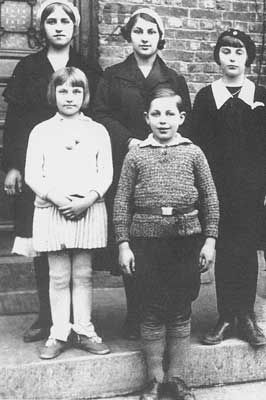 Beauraing, Belgium is a small farming village that lies about sixty miles southeast of Brussels. At the time of the apparitions, the population numbered just 2000. Depression was upon Europe, and unemployment, poverty, and hunger were common. The faithful were falling away from the Church, and anti-Christian political movements were gaining power. The Voisins and the Degeimbres remained practicing Catholics at that time, although only sporadically. However, like many families in Europe at the time, they continued to send one of their children to be educated at a Catholic school. Gilberte was to receive a Catholic education from the Sisters of Christian Doctrine. Each night, Gilberte’s older sister, Fernande (age 15) and younger brother, Albert (age 11) went to meet their sister at the academy after school. This was nothing unusual – they would often walk Gilberte home. On the way to the academy two other girls joined them: Andree Degeimbre (age 14) and Gilberte Degeimbre (age 9). All the children were friends.
Beauraing, Belgium is a small farming village that lies about sixty miles southeast of Brussels. At the time of the apparitions, the population numbered just 2000. Depression was upon Europe, and unemployment, poverty, and hunger were common. The faithful were falling away from the Church, and anti-Christian political movements were gaining power. The Voisins and the Degeimbres remained practicing Catholics at that time, although only sporadically. However, like many families in Europe at the time, they continued to send one of their children to be educated at a Catholic school. Gilberte was to receive a Catholic education from the Sisters of Christian Doctrine. Each night, Gilberte’s older sister, Fernande (age 15) and younger brother, Albert (age 11) went to meet their sister at the academy after school. This was nothing unusual – they would often walk Gilberte home. On the way to the academy two other girls joined them: Andree Degeimbre (age 14) and Gilberte Degeimbre (age 9). All the children were friends. As was their habit, the four ran through the quiet town, playing games and mischievously playing pranks on their neighbors in the dark night. That night, however, something was different. November 29, 1932 would mark their first encounter with “the beautiful lady,” although only from a distance. Upon arriving at the convent, the four children played in the garden, waiting for Gilberte to finish school. In the garden was a small statue of Our Lady of Lourdes. Beyond the garden was the street, and above it a small railroad bridge. As the four were playing, Albert glanced at the bridge, and noticed a lady, dressed all in white, floating as if walking on air above them. As he watched, he clearly could make out the figure bending her knees, walking.
Albert shouted to the others, gaining their attention, and gesturing at the bridge. “It’s the Virgin walking above the bridge!” he exclaimed, his voice noticeably higher and slightly peculiar sounding to the others. They were surprised—even curious—but thought him to be joking. But upon closer examination, they, too, saw her and confirmed “she could be the Blessed Virgin Mary!”
As they were marveling at the appearance of the beautiful lady walking on air, Sister Valeria, Gilberte’s teacher, opened the academy door to allow Gilberte to join her friends. Immediately, she sensed something different about the children. Rather than laughing and joking, they were all quite pale, and somehow appeared anxious. They ran to her, and quickly told her of their vision, pointing to the bridge, and exclaiming their faith. Sister Valeria saw nothing, however, and moved into the garden, turned on lights, and squinted… but she saw no lady on the bridge.
Sister Valeria scolded the children, thinking them playing a prank. Upon turning, however, she discovered that Gilberte—who had been with her, and could not have been involved in this trickery—too, saw the beautiful lady. Gilberte described her as wearing a long, white gown and a long, silk veil that flowed to a small cloud covering her feet—as if walking on air! The beautiful lady gave off a radiant light, which grew in intensity as she approached. Her hands were folded in prayer, and as she neared them, she smiled, but said nothing. Later, all they could say was that her eyes were a deep and magnetic blue, and that she was beautiful.
Sister Valeria, cold and irritated, sent the children away, instructing them not to play pranks, nor to tell anyone the story they had told her. At supper, however, she recounted their story to the Superior Mother of the house, but was instructed to forget it as it was simply the immature story of a group of children. The children, for their part, ran home and immediately told their parents, eager to share their exciting news. Of course, they were not believed, and instead, were scolded for lying. Their friends teased them the next day, and several were taken to see the family physician, as they were concerned for their mental health.
Over the next several nights, however, the children would see Our Blessed Mother on the bridge again, always walking toward them, never speaking. After repeatedly telling their parents, they were encouraged to ask the Lady her name. This they would courageously do on December 2, the evening of the next phase of apparitions.
Our Lady would return to the children thirty-three times over the next 10 weeks, bringing with her a message of peace, penance, and prayer for the conversion of sinners. Our Blessed Mother graced us with her golden heart, encouraging us to sacrifice ourselves for the Lord, and for the salvation of the world. We pray today, on the anniversary of the first apparition, for conversion of sinners, peace, and salvation.
Our Lady of Beauraing, Immaculate Virgin, bring to Jesus, your Son, all the intentions that we entrust to you today. Mother of the Golden Heart, reflection of the Father's tenderness, look upon the men and women of our time with love and fill them with the joy of your presence. You, who promised to convert sinners, help us discover the infinite mercy of our God. Awaken within us the grace of conversion so that our lives may be a reflection of that mercy. Make every moment of our existence "a yes" to the question you ask today: "Do you love my Son? Do you love me?" Then the kingdom of Jesus will come to the world. Amen.
Day 333 of 365
Prayer Intentions: Conversion; Peace; Salvation.
Requested Intentions: Healing of a family and son (S); Successful marriage (G); End to husband’s addictions; Son’s employment (M); Freedom from financial burdens (M); Healing after a miscarriage (E); For healing of friend; successful resolution of legal matter (A); For unity between estranged friends (E); For a son, falsely arrested (C); Successful employment (J); Successful employment (L); For a healthy child (L); Recovery from stomach illness of a friend (A); Employment and financial security (E); Conversion of sons (L); Freedom from financial stress, employment (C); Spiritual growth and family peace (A); Freedom to immigrate (D); End to debt (N); Restoration of a marriage (J); Complete recovery of son (P); Recovery of parish priest, health of mother, conversion of son (J); Successful employment, end to depression (J); Successful immigration and employment (S); Conversion of an unloving daughter (M); Recovery of husband, health of mother, economic freedom (R); Freedom from depression, restoration of family relationships (N); Restoration of a relationship (J); Healing of friends from cancer (J); Complete healing of a friend with pancreatic cancer (J); Healing of a father following stroke (S).
"Beloved and most holy word of God! You enlighten the hearts of the faithful, you satisfy the hungry, console the afflicted; you make the souls of all productive of good and cause all virtues to blossom; you snatch souls from the devil’s jaw; you make the wretched holy, and men of earth citizens of heaven!"
Today, November 28, we celebrate the feast day of Saint James of the Marches (Giacomo della Marca, 1391-1476), Franciscan friar, missionary, preacher, and opponent of heresy. The life of Saint James is remarkable for his commitment to defense of Church doctrine, his tireless preaching and conversions of sinners, miracle working, and austerity.
James Gangala was born into an extremely poor family at Montebrandone (in the Marche of Ancona), in central Italy along the Adriatic Sea. Drawn to the Lord, he began his studies at Offida under the guidance of his uncle, a priest, who soon afterwards put him to school at Ascoli. At the University of Perugia he took the degree of Doctor in Civil Law. After a short stay at Florence as tutor in a noble family, and as judge of sorcerers, James was received into the Order of the Friars Minor, the Franciscan order at Assisi, at the age of 25. Studying under Saint Bernardino of Siena, James was widely recognized for his oratory, delivering both forceful and effective sermons, and converting thousands of souls. Ordained at age twenty-nine, James was sent on mission with Saint John Capistrano, traveling throughout Italy, German, Bohemia, Poland, and Hungary.
Noting his orthodoxy, Pope Saint Martin V appointed him inquisitor to root out heretical sects that were growing in power throughout Italy. He continued his travels, preaching, working against heresy, and attempting to reconcile various branches of the Franciscan Order. He attended the Council of Florence in 1438, working diligently to reconcile the Eastern and Latin Churches, with little success.
Elected bishop of Milan, James humbly declined the position, preferring to continue his itinerant lifestyle, traveling, preaching, and confirming the truth of Church doctrine. Saint James preached every day for 40 years, beginning on the date of his ordination, and ending on the date of his death. He preached a message of penance, which he also put into practice. James slept only three hours each evening, and fasted nine months of the year. Thin, dressed always in the same tattered brown robe, and susceptible to illness, Saint James ate little, giving all he had to the needy. As he grew older, and his health began to observably fail, Pope Martin V ordered him to eat regularly, as a public service, so that he could continue his ministry. Charitable, Saint James instituted several montes pietatis, (literally, “mountains of money”), which provided low-interest loans to all who needed them.
Saint James founded several monasteries in Bohemia, Hungary, and Austria. Especially devoted to the Precious Blood of Jesus, he, himself, was brought up on heresy charges during the Dominican Inquisition in 1462. The Pope intervened, ordering the case put on permanent hold, with no decision ever rendered on his statements. However, during the course of the inquisition, James was the victim of attempted assassination twice, both times in the form of a poisoned chalice (as he is frequently depicted in art).
Saint James spent the last three years of his life at Naples, and was buried there in the Franciscan church of San Maria la Nuova, where his body is still to be seen, preserved beneath the alter. Numerous miracles have been reported through his intercession, both while he lived and subsequent to his death.
On today, the feast of Saint James of the Marches, we pray for the fortitude, steadfastness, and endurance that this holy man displayed each day of his life. Saint James, pray for us!
A Prayer for Fortitude
O Holy Spirit who descended upon the twelve as they stood in anxiety, come unto me in my endeavors. Banish from my heart all timidity and false pride; strengthen my soul to avoid all sin, to practice virtue, and to prefer ridicule to the denial of my Lord and Savior Jesus Christ. Let not the goodness of purity, obedience and charity be obscured in the face of adversity. Instill in me the virtue of Fortitude so that I may courageously profess and practice my holy Catholic faith. Open my eyes, O Holy Spirit, that I may recognize my state in life. Give me the confidence to embrace it and the strength to live it as a son of God. I pray that Your guidance, protection and consolation may be with me now and throughout my life. Amen.
Day 332 of 365
Prayer Intentions: Fortitude, Steadfastness, Endurance.
Requested Intentions: Healing of a family and son (S); Successful marriage (G); End to husband’s addictions; Son’s employment (M); Freedom from financial burdens (M); Healing after a miscarriage (E); For healing of friend; successful resolution of legal matter (A); For unity between estranged friends (E); For a son, falsely arrested (C); Successful employment (J); Successful employment (L); For a healthy child (L); Recovery from stomach illness of a friend (A); Employment and financial security (E); Conversion of sons (L); Freedom from financial stress, employment (C); Spiritual growth and family peace (A); Freedom to immigrate (D); End to debt (N); Restoration of a marriage (J); Complete recovery of son (P); Recovery of parish priest, health of mother, conversion of son (J); Successful employment, end to depression (J); Successful immigration and employment (S); Conversion of an unloving daughter (M); Recovery of husband, health of mother, economic freedom (R); Freedom from depression, restoration of family relationships (N); Restoration of a relationship (J); Healing of friends from cancer (J); Complete healing of a friend with pancreatic cancer (J); Healing of a father following stroke (S).
Today, November 28, we celebrate the feast day of Saint James of the Marches (Giacomo della Marca, 1391-1476), Franciscan friar, missionary, preacher, and opponent of heresy. The life of Saint James is remarkable for his commitment to defense of Church doctrine, his tireless preaching and conversions of sinners, miracle working, and austerity.
James Gangala was born into an extremely poor family at Montebrandone (in the Marche of Ancona), in central Italy along the Adriatic Sea. Drawn to the Lord, he began his studies at Offida under the guidance of his uncle, a priest, who soon afterwards put him to school at Ascoli. At the University of Perugia he took the degree of Doctor in Civil Law. After a short stay at Florence as tutor in a noble family, and as judge of sorcerers, James was received into the Order of the Friars Minor, the Franciscan order at Assisi, at the age of 25. Studying under Saint Bernardino of Siena, James was widely recognized for his oratory, delivering both forceful and effective sermons, and converting thousands of souls. Ordained at age twenty-nine, James was sent on mission with Saint John Capistrano, traveling throughout Italy, German, Bohemia, Poland, and Hungary.
Noting his orthodoxy, Pope Saint Martin V appointed him inquisitor to root out heretical sects that were growing in power throughout Italy. He continued his travels, preaching, working against heresy, and attempting to reconcile various branches of the Franciscan Order. He attended the Council of Florence in 1438, working diligently to reconcile the Eastern and Latin Churches, with little success.
Elected bishop of Milan, James humbly declined the position, preferring to continue his itinerant lifestyle, traveling, preaching, and confirming the truth of Church doctrine. Saint James preached every day for 40 years, beginning on the date of his ordination, and ending on the date of his death. He preached a message of penance, which he also put into practice. James slept only three hours each evening, and fasted nine months of the year. Thin, dressed always in the same tattered brown robe, and susceptible to illness, Saint James ate little, giving all he had to the needy. As he grew older, and his health began to observably fail, Pope Martin V ordered him to eat regularly, as a public service, so that he could continue his ministry. Charitable, Saint James instituted several montes pietatis, (literally, “mountains of money”), which provided low-interest loans to all who needed them.
Saint James founded several monasteries in Bohemia, Hungary, and Austria. Especially devoted to the Precious Blood of Jesus, he, himself, was brought up on heresy charges during the Dominican Inquisition in 1462. The Pope intervened, ordering the case put on permanent hold, with no decision ever rendered on his statements. However, during the course of the inquisition, James was the victim of attempted assassination twice, both times in the form of a poisoned chalice (as he is frequently depicted in art).
Saint James spent the last three years of his life at Naples, and was buried there in the Franciscan church of San Maria la Nuova, where his body is still to be seen, preserved beneath the alter. Numerous miracles have been reported through his intercession, both while he lived and subsequent to his death.
On today, the feast of Saint James of the Marches, we pray for the fortitude, steadfastness, and endurance that this holy man displayed each day of his life. Saint James, pray for us!
A Prayer for Fortitude
O Holy Spirit who descended upon the twelve as they stood in anxiety, come unto me in my endeavors. Banish from my heart all timidity and false pride; strengthen my soul to avoid all sin, to practice virtue, and to prefer ridicule to the denial of my Lord and Savior Jesus Christ. Let not the goodness of purity, obedience and charity be obscured in the face of adversity. Instill in me the virtue of Fortitude so that I may courageously profess and practice my holy Catholic faith. Open my eyes, O Holy Spirit, that I may recognize my state in life. Give me the confidence to embrace it and the strength to live it as a son of God. I pray that Your guidance, protection and consolation may be with me now and throughout my life. Amen.
Day 332 of 365
Prayer Intentions: Fortitude, Steadfastness, Endurance.
Requested Intentions: Healing of a family and son (S); Successful marriage (G); End to husband’s addictions; Son’s employment (M); Freedom from financial burdens (M); Healing after a miscarriage (E); For healing of friend; successful resolution of legal matter (A); For unity between estranged friends (E); For a son, falsely arrested (C); Successful employment (J); Successful employment (L); For a healthy child (L); Recovery from stomach illness of a friend (A); Employment and financial security (E); Conversion of sons (L); Freedom from financial stress, employment (C); Spiritual growth and family peace (A); Freedom to immigrate (D); End to debt (N); Restoration of a marriage (J); Complete recovery of son (P); Recovery of parish priest, health of mother, conversion of son (J); Successful employment, end to depression (J); Successful immigration and employment (S); Conversion of an unloving daughter (M); Recovery of husband, health of mother, economic freedom (R); Freedom from depression, restoration of family relationships (N); Restoration of a relationship (J); Healing of friends from cancer (J); Complete healing of a friend with pancreatic cancer (J); Healing of a father following stroke (S).
“Have a medal struck upon this model. Those who wear it will receive great graces, especially if they wear it around the neck. Graces will be abundant for those who pray with confidence.”
- Words of Our Lady to Saint Catherine Laboure, November 27, 1830
Today, November 27, we celebrate the feast of Our Lady of the Miraculous Medal. On July 18, we commemorated the first apparition of Our Blessed Mother, Our Lady of the Miraculous Medal, to Saint Catherine Labouré at the convent at Rue du Bac in Paris. Over the course of three apparitions, the second of which we commemorate today, Our Blessed Mother detailed to Saint Catherine the evils of the world, encouraged her to pray for salvation, and provided a means in which for the holy to consecrate themselves to her Sacred Heart, providing protection and grace.
In July 1830, Saint Catherine had been in the convent chapel, praying to Saint Vincent de Paul, voicing her desire to see the Blessed Virgin. Retiring to her room, she attempted to sleep, when a mysterious child appeared at the foot of her bed. The child, in a pure, sweet voice, encouraged her, saying, “Sister Catherine, Sister Catherine, get up quickly. Come to the chapel. Our Lady is waiting for you.” Upon arrival at the chapel, Saint Catherine was graced by a visit from Our Blessed Mother. She wrote, “I then bounded to the steps of the altar, knelt, and let my hands rest on the knees of the Blessed Virgin. There I spent the most pleasant time of my life. It would be impossible for me to describe what I experienced. The Blessed Virgin told me how I should conduct myself with regard to my confessor and many other things.”
On that first meeting, Our Lady warned Catherine of the trials and dangers to come, the persecution of the Church, and the difficulties that lie ahead for the world. She then said to Saint Catherine, setting the stage for the later events of her life, “My child, the good God wishes to give you a mission. Later I shall let you know what it is. You will have much to suffer.” Noting Catherine’s worry, Our Gentle Mother said: “Do not be afraid of difficulties. Pray to Jesus present in the Blessed Sacrament. But do not be afraid.”
Saint Catherine did not see the Holy Virgin again until November 27. In the early morning Catherine was praying in the chapel when she heard the familiar “swish” of silk that she remembered from Mary’s first visit. Again, Our Blessed Mother appeared, dressed in a white, long sleeved gown. Her head was covered by a white veil trailing to her feet. Saint Catherine described her as:
“Her height was medium and her countenance, indescribably beautiful. She was dressed in a robe the color of the dawn, high-necked, with plain sleeves. Her head was covered with a white veil, which floated over Her shoulders down to her feet. Her feet rested upon a globe, or rather one half of a globe, for that was all that could be seen. Her hands which were on a level with her waist, held in an easy manner another globe, a figure of the world. Her eyes were raised to Heaven, and her countenance beamed with light as She offered the globe to Our Lord.” When she tried to describe her face, Catherine was only able to say: “it was the Virgin Mary in her maximum beauty.“
Our Blessed Mother, in this appearance, was standing atop of a white globe, crushing a green serpent with yellow dots beneath her feet. Her hands where elevated to her heart, and she was holding another small globe of gold, crowned with a cross, which she offered in supplication to the Lord. Her eyes were raised to heaven, although would return to gaze upon Saint Catherine and the earth held in her precious hands. During the apparition, rings of precious stones appeared upon her hands, shining so brightly that she became impossible to gaze upon. Some rings, adorned with pearls, failed to shine.
While Sister Catherine was gazing in love and contemplation, an interior voice filled her head and heart. Mary said to her: “This globe you see [at her feet] represents the whole world, specially France and each soul in particular. The rays symbolizes the graces that I give to those who ask for them. The pearls that don’t have rays are the graces of the souls who don’t ask.”
As Saint Catherine gazed upon her, the globe of gold (symbolizing the richness of graces) disappeared, and Our Blessed Mother extended her arms outward so that the rays of light emanating from her ringed hands fell upon the globe at her feet. An oval appeared in the air around her, and inside of the oval, an inscription formed a semi-circle from her right hand, above her head, to her left hand: “Mary conceived without sin, pray for us, who recourse to thee.”
Saint Catherine, in the quiet of her heart, then received her mission from Mary: “Have a medal made according to this model. All those who wear it will receive great graces. The graces will more abundant for those who wear it confidence.“ Catherine was then graced with a view of the reverse side of the medal.
Explanation of the Miraculous Medal:
On the one side, Mary is standing upon a globe, crushing the head of a serpent beneath her foot. She stands upon the globe, as the Queen of Heaven and Earth. Her feet crush the serpent to proclaim Satan and all his followers are helpless before her. The year of 1830 on the Miraculous Medal is the year the Blessed Mother gave the design to Saint Catherine. The reference to “Mary conceived without sin” supports the dogma of the Immaculate Conception of Mary.
On the reverse side of the medal there are twelve stars that encircle a large “M” from which arises a cross. Below are two hearts with flames rising from them. One heart is encircled in thorns and the other is pierced by a sword. The twelve stars refer to the Apostles, who represent the entire Church as it surrounds Mary. They also recall the vision of Saint John, as recorded in Revelation (12:1), in which “a great sign appeared in heaven, a woman clothed with the sun, and the moon under her feet, and on her head a crown of 12 stars.” The cross symbolizes Jesus Christ, the Son of God, and our redemption, with the bar under the cross a sign of the earth. The “M” signifies Mary, and the interleaving of her initial and the cross shows Mary’s close involvement with Jesus and our world. In this we see Mary’s part in our salvation and her role as mother of the Church. The two hearts represent the love of Jesus and Mary for us.
Following her description of Saint Catherine’s mission, Our Blessed Mother again disappeared. Saint Catherine informed her spiritual advisor, who did not initially believe her. Over the following year, Catherine was graced with return apparitions, each time receiving the same instructions. She eventually convinced her spiritual advisor, who promptly informed the bishop of Paris. The bishop allowed the striking of the medals, even requesting some himself for distribution. Soon thereafter, miracles began being reported at the intercession of Our Blessed Mother, due to the medals. While initially called medals of the Immaculate Conception, due to the number of miracles reported, the faithful soon began referring to it as “the Miraculous Medal.”
Saint Catherine maintained a vow of silence until shortly before her death, only then revealing to her Mother Superior that it was she, in fact, who had received the instructions regarding the miraculous medal. Her days were spent in prayer, placed confidently in the hands of Our Blessed Mother.
Daily Miraculous Medal Prayer of Saint Maximilian Kolbe:
O Mary, conceived without sin, pray for us who have recourse to you, and for all who do not have recourse to you, especially the enemies of the Church and those recommended to you. Amen.
Consecration to Our Lady of the Miraculous Medal
Virgin Mother of God, Mary Immaculate,
we unite ourselves to you under your title of
Our Lady of the Miraculous Medal.
May this medal be for each one of us
a sure sign of your motherly affection for us and a
constant reminder of our filial duties towards you.
While wearing it, may we be blessed by your loving protection
and preserved in the grace of your Son.
Most powerful Virgin, Mother of our Savior,
keep us close to you every moment of our lives
so that like you we may live and act
according to the teaching and example of your Son.
Obtain for us, your children, the grace of a happy death
so that in union with you we may enjoy
the happiness of heaven forever.
Amen.
O Mary, conceived without sin,
pray for us who have recourse to you.
Day 330 of 365
Prayer Intentions: Confidence in the graces and blessings of Our Mother.
Requested Intentions: Healing of a family and son (S); Successful marriage (G); End to husband’s addictions; Son’s employment (M); Freedom from financial burdens (M); Healing after a miscarriage (E); For healing of friend; successful resolution of legal matter (A); For unity between estranged friends (E); For a son, falsely arrested (C); Successful employment (J); Successful employment (L); For a healthy child (L); Recovery from stomach illness of a friend (A); Employment and financial security (E); Conversion of sons (L); Freedom from financial stress, employment (C); Spiritual growth and family peace (A); Freedom to immigrate (D); End to debt (N); Restoration of a marriage (J); Complete recovery of son (P); Recovery of parish priest, health of mother, conversion of son (J); Successful employment, end to depression (J); Successful immigration and employment (S); Conversion of an unloving daughter (M); Recovery of husband, health of mother, economic freedom (R); Freedom from depression, restoration of family relationships (N); Restoration of a relationship (J); Healing of friends from cancer (J); Complete healing of a friend with pancreatic cancer (J); Healing of a father following stroke (S).
- Words of Our Lady to Saint Catherine Laboure, November 27, 1830
Today, November 27, we celebrate the feast of Our Lady of the Miraculous Medal. On July 18, we commemorated the first apparition of Our Blessed Mother, Our Lady of the Miraculous Medal, to Saint Catherine Labouré at the convent at Rue du Bac in Paris. Over the course of three apparitions, the second of which we commemorate today, Our Blessed Mother detailed to Saint Catherine the evils of the world, encouraged her to pray for salvation, and provided a means in which for the holy to consecrate themselves to her Sacred Heart, providing protection and grace.
In July 1830, Saint Catherine had been in the convent chapel, praying to Saint Vincent de Paul, voicing her desire to see the Blessed Virgin. Retiring to her room, she attempted to sleep, when a mysterious child appeared at the foot of her bed. The child, in a pure, sweet voice, encouraged her, saying, “Sister Catherine, Sister Catherine, get up quickly. Come to the chapel. Our Lady is waiting for you.” Upon arrival at the chapel, Saint Catherine was graced by a visit from Our Blessed Mother. She wrote, “I then bounded to the steps of the altar, knelt, and let my hands rest on the knees of the Blessed Virgin. There I spent the most pleasant time of my life. It would be impossible for me to describe what I experienced. The Blessed Virgin told me how I should conduct myself with regard to my confessor and many other things.”
On that first meeting, Our Lady warned Catherine of the trials and dangers to come, the persecution of the Church, and the difficulties that lie ahead for the world. She then said to Saint Catherine, setting the stage for the later events of her life, “My child, the good God wishes to give you a mission. Later I shall let you know what it is. You will have much to suffer.” Noting Catherine’s worry, Our Gentle Mother said: “Do not be afraid of difficulties. Pray to Jesus present in the Blessed Sacrament. But do not be afraid.”
Saint Catherine did not see the Holy Virgin again until November 27. In the early morning Catherine was praying in the chapel when she heard the familiar “swish” of silk that she remembered from Mary’s first visit. Again, Our Blessed Mother appeared, dressed in a white, long sleeved gown. Her head was covered by a white veil trailing to her feet. Saint Catherine described her as:
“Her height was medium and her countenance, indescribably beautiful. She was dressed in a robe the color of the dawn, high-necked, with plain sleeves. Her head was covered with a white veil, which floated over Her shoulders down to her feet. Her feet rested upon a globe, or rather one half of a globe, for that was all that could be seen. Her hands which were on a level with her waist, held in an easy manner another globe, a figure of the world. Her eyes were raised to Heaven, and her countenance beamed with light as She offered the globe to Our Lord.” When she tried to describe her face, Catherine was only able to say: “it was the Virgin Mary in her maximum beauty.“
Our Blessed Mother, in this appearance, was standing atop of a white globe, crushing a green serpent with yellow dots beneath her feet. Her hands where elevated to her heart, and she was holding another small globe of gold, crowned with a cross, which she offered in supplication to the Lord. Her eyes were raised to heaven, although would return to gaze upon Saint Catherine and the earth held in her precious hands. During the apparition, rings of precious stones appeared upon her hands, shining so brightly that she became impossible to gaze upon. Some rings, adorned with pearls, failed to shine.
While Sister Catherine was gazing in love and contemplation, an interior voice filled her head and heart. Mary said to her: “This globe you see [at her feet] represents the whole world, specially France and each soul in particular. The rays symbolizes the graces that I give to those who ask for them. The pearls that don’t have rays are the graces of the souls who don’t ask.”
As Saint Catherine gazed upon her, the globe of gold (symbolizing the richness of graces) disappeared, and Our Blessed Mother extended her arms outward so that the rays of light emanating from her ringed hands fell upon the globe at her feet. An oval appeared in the air around her, and inside of the oval, an inscription formed a semi-circle from her right hand, above her head, to her left hand: “Mary conceived without sin, pray for us, who recourse to thee.”
Saint Catherine, in the quiet of her heart, then received her mission from Mary: “Have a medal made according to this model. All those who wear it will receive great graces. The graces will more abundant for those who wear it confidence.“ Catherine was then graced with a view of the reverse side of the medal.
Explanation of the Miraculous Medal:
On the one side, Mary is standing upon a globe, crushing the head of a serpent beneath her foot. She stands upon the globe, as the Queen of Heaven and Earth. Her feet crush the serpent to proclaim Satan and all his followers are helpless before her. The year of 1830 on the Miraculous Medal is the year the Blessed Mother gave the design to Saint Catherine. The reference to “Mary conceived without sin” supports the dogma of the Immaculate Conception of Mary.
On the reverse side of the medal there are twelve stars that encircle a large “M” from which arises a cross. Below are two hearts with flames rising from them. One heart is encircled in thorns and the other is pierced by a sword. The twelve stars refer to the Apostles, who represent the entire Church as it surrounds Mary. They also recall the vision of Saint John, as recorded in Revelation (12:1), in which “a great sign appeared in heaven, a woman clothed with the sun, and the moon under her feet, and on her head a crown of 12 stars.” The cross symbolizes Jesus Christ, the Son of God, and our redemption, with the bar under the cross a sign of the earth. The “M” signifies Mary, and the interleaving of her initial and the cross shows Mary’s close involvement with Jesus and our world. In this we see Mary’s part in our salvation and her role as mother of the Church. The two hearts represent the love of Jesus and Mary for us.
Following her description of Saint Catherine’s mission, Our Blessed Mother again disappeared. Saint Catherine informed her spiritual advisor, who did not initially believe her. Over the following year, Catherine was graced with return apparitions, each time receiving the same instructions. She eventually convinced her spiritual advisor, who promptly informed the bishop of Paris. The bishop allowed the striking of the medals, even requesting some himself for distribution. Soon thereafter, miracles began being reported at the intercession of Our Blessed Mother, due to the medals. While initially called medals of the Immaculate Conception, due to the number of miracles reported, the faithful soon began referring to it as “the Miraculous Medal.”
Saint Catherine maintained a vow of silence until shortly before her death, only then revealing to her Mother Superior that it was she, in fact, who had received the instructions regarding the miraculous medal. Her days were spent in prayer, placed confidently in the hands of Our Blessed Mother.
Daily Miraculous Medal Prayer of Saint Maximilian Kolbe:
O Mary, conceived without sin, pray for us who have recourse to you, and for all who do not have recourse to you, especially the enemies of the Church and those recommended to you. Amen.
Consecration to Our Lady of the Miraculous Medal
Virgin Mother of God, Mary Immaculate,
we unite ourselves to you under your title of
Our Lady of the Miraculous Medal.
May this medal be for each one of us
a sure sign of your motherly affection for us and a
constant reminder of our filial duties towards you.
While wearing it, may we be blessed by your loving protection
and preserved in the grace of your Son.
Most powerful Virgin, Mother of our Savior,
keep us close to you every moment of our lives
so that like you we may live and act
according to the teaching and example of your Son.
Obtain for us, your children, the grace of a happy death
so that in union with you we may enjoy
the happiness of heaven forever.
Amen.
O Mary, conceived without sin,
pray for us who have recourse to you.
Day 330 of 365
Prayer Intentions: Confidence in the graces and blessings of Our Mother.
Requested Intentions: Healing of a family and son (S); Successful marriage (G); End to husband’s addictions; Son’s employment (M); Freedom from financial burdens (M); Healing after a miscarriage (E); For healing of friend; successful resolution of legal matter (A); For unity between estranged friends (E); For a son, falsely arrested (C); Successful employment (J); Successful employment (L); For a healthy child (L); Recovery from stomach illness of a friend (A); Employment and financial security (E); Conversion of sons (L); Freedom from financial stress, employment (C); Spiritual growth and family peace (A); Freedom to immigrate (D); End to debt (N); Restoration of a marriage (J); Complete recovery of son (P); Recovery of parish priest, health of mother, conversion of son (J); Successful employment, end to depression (J); Successful immigration and employment (S); Conversion of an unloving daughter (M); Recovery of husband, health of mother, economic freedom (R); Freedom from depression, restoration of family relationships (N); Restoration of a relationship (J); Healing of friends from cancer (J); Complete healing of a friend with pancreatic cancer (J); Healing of a father following stroke (S).
Today, November 26, we celebrate the feast day of Saint Leonard of Port Maurice (1676-1751), a Franciscan friar, preacher, and writer. Saint Leonard’s devotion to the Stations of the Cross, and his fierce sermons on the salvation of souls converted thousands as he preached in the great town squares across Europe. He was one of the greatest missionaries of the Church.
One of Saint Leonard of Port Maurice's most famous sermons was "The Little Number of Those Who Are Saved." It was the one he relied on for the conversion of great sinners. In it he reviews the various states of life of Christians and concludes with the little number of those who are saved, in relation to the totality of men. Below is an excerpt from this famous sermon.
Introduction
Thanks be to God, the number of the Redeemer's disciples is not so small that the wickedness of the Scribes and Pharisees is able to triumph over them. Although they strove to calumniate innocence and to deceive the crowd with their treacherous sophistries by discrediting the doctrine and character of Our Lord, finding spots even in the sun, many still recognized Him as the true Messiah, and, unafraid of either chastisements or threats, openly joined His cause. Did all those who followed Christ follow Him even unto glory? Oh, this is where I revere the profound mystery and silently adore the abysses of the divine decrees, rather than rashly deciding on such a great point! The subject I will be treating today is a very grave one; it has caused even the pillars of the Church to tremble, filled the greatest Saints with terror and populated the deserts with anchorites. The point of this instruction is to decide whether the number of Christians who are saved is greater or less than the number of Christians who are damned; it will, I hope, produce in you a salutary fear of the judgments of God.
Brothers, because of the love I have for you, I wish I were able to reassure you with the prospect of eternal happiness by saying to each of you: You are certain to go to paradise; the greater number of Christians is saved, so you also will be saved. But how can I give you this sweet assurance if you revolt against God's decrees as though you were your own worst enemies? I observe in God a sincere desire to save you, but I find in you a decided inclination to be damned. So what will I be doing today if I speak clearly? I will be displeasing to you. But if I do not speak, I will be displeasing to God.
Therefore, I will divide this subject into two points. In the first one, to fill you with dread, I will let the theologians and Fathers of the Church decide on the matter and declare that the greater number of Christian adults are damned; and, in silent adoration of that terrible mystery, I will keep my own sentiments to myself. In the second point I will attempt to defend the goodness of God versus the godless, by proving to you that those who are damned are damned by their own malice, because they wanted to be damned. So then, here are two very important truths. If the first truth frightens you, do not hold it against me, as though I wanted to make the road of heaven narrower for you, for I want to be neutral in this matter; rather, hold it against the theologians and Fathers of the Church who will engrave this truth in your heart by the force of reason. If you are disillusioned by the second truth, give thanks to God over it, for He wants only one thing: that you give your hearts totally to Him. Finally, if you oblige me to tell you clearly what I think, I will do so for your consolation.
 I would not finish if I had to point out all the figures by which Holy Scripture confirms this truth; let us content ourselves with listening to the living oracle of Incarnate Wisdom. What did Our Lord answer the curious man in the Gospel who asked Him, "Lord, is it only a few to be saved?" Did He keep silence? Did He answer haltingly? Did He conceal His thought for fear of frightening the crowd? No. Questioned by only one, He addresses all of those present. He says to them: "You ask Me if there are only few who are saved?" Here is My answer: "Strive to enter by the narrow gate; for many, I tell you, will seek to enter and will not be able." Who is speaking here? It is the Son of God, Eternal Truth, who on another occasion says even more clearly, "Many are called, but few are chosen." He does not say that all are called and that out of all men, few are chosen, but that many are called; which means, as Saint Gregory explains, that out of all men, many are called to the True Faith, but out of them few are saved. Brothers, these are the words of Our Lord Jesus Christ. Are they clear? They are true. Tell me now if it is possible for you to have faith in your heart and not tremble.
I would not finish if I had to point out all the figures by which Holy Scripture confirms this truth; let us content ourselves with listening to the living oracle of Incarnate Wisdom. What did Our Lord answer the curious man in the Gospel who asked Him, "Lord, is it only a few to be saved?" Did He keep silence? Did He answer haltingly? Did He conceal His thought for fear of frightening the crowd? No. Questioned by only one, He addresses all of those present. He says to them: "You ask Me if there are only few who are saved?" Here is My answer: "Strive to enter by the narrow gate; for many, I tell you, will seek to enter and will not be able." Who is speaking here? It is the Son of God, Eternal Truth, who on another occasion says even more clearly, "Many are called, but few are chosen." He does not say that all are called and that out of all men, few are chosen, but that many are called; which means, as Saint Gregory explains, that out of all men, many are called to the True Faith, but out of them few are saved. Brothers, these are the words of Our Lord Jesus Christ. Are they clear? They are true. Tell me now if it is possible for you to have faith in your heart and not tremble.
The Goodness of God
Perhaps you do not yet believe the terrible truths I have just taught you. But it is the most highly-considered theologians, the most illustrious Fathers who have spoken to you through me. So then, how can you resist reasons supported by so many examples and words of Scripture? If you still hesitate in spite of that, and if your mind is inclined to the opposite opinion, does that very consideration not suffice to make you tremble? Oh, it shows that you do not care very much for your salvation! In this important matter, a sensible man is struck more strongly by the slightest doubt of the risk he runs than by the evidence of total ruin in other affairs in which the soul is not involved. One of our brothers, Blessed Giles, was in the habit of saying that if only one man were going to be damned, he would do all he could to make sure he was not that man.
So what must we do, we who know that the greater number is going to be damned, and not only out of all Catholics? What must we do? Take the resolution to belong to the little number of those who are saved. You say: If Christ wanted to damn me, then why did He create me? Silence, rash tongue! God did not create anyone to damn him; but whoever is damned, is damned because he wants to be. Therefore, I will now strive to defend the goodness of my God and acquit it of all blame: that will be the subject of the second point.
Before going on, let us gather on one side all the books and all the heresies of Luther and Calvin, and on the other side the books and heresies of the Pelagians and Semi-Pelagians, and let us burn them. Some destroy grace, others freedom, and all are filled with errors; so let us cast them into the fire. All the damned bear upon their brow the oracle of the Prophet Osee, "Thy damnation comes from thee," so that they may understand that whoever is damned, is damned by his own malice and because he wants to be damned.
One of Saint Leonard of Port Maurice's most famous sermons was "The Little Number of Those Who Are Saved." It was the one he relied on for the conversion of great sinners. In it he reviews the various states of life of Christians and concludes with the little number of those who are saved, in relation to the totality of men. Below is an excerpt from this famous sermon.
Introduction
Thanks be to God, the number of the Redeemer's disciples is not so small that the wickedness of the Scribes and Pharisees is able to triumph over them. Although they strove to calumniate innocence and to deceive the crowd with their treacherous sophistries by discrediting the doctrine and character of Our Lord, finding spots even in the sun, many still recognized Him as the true Messiah, and, unafraid of either chastisements or threats, openly joined His cause. Did all those who followed Christ follow Him even unto glory? Oh, this is where I revere the profound mystery and silently adore the abysses of the divine decrees, rather than rashly deciding on such a great point! The subject I will be treating today is a very grave one; it has caused even the pillars of the Church to tremble, filled the greatest Saints with terror and populated the deserts with anchorites. The point of this instruction is to decide whether the number of Christians who are saved is greater or less than the number of Christians who are damned; it will, I hope, produce in you a salutary fear of the judgments of God.
Brothers, because of the love I have for you, I wish I were able to reassure you with the prospect of eternal happiness by saying to each of you: You are certain to go to paradise; the greater number of Christians is saved, so you also will be saved. But how can I give you this sweet assurance if you revolt against God's decrees as though you were your own worst enemies? I observe in God a sincere desire to save you, but I find in you a decided inclination to be damned. So what will I be doing today if I speak clearly? I will be displeasing to you. But if I do not speak, I will be displeasing to God.
Therefore, I will divide this subject into two points. In the first one, to fill you with dread, I will let the theologians and Fathers of the Church decide on the matter and declare that the greater number of Christian adults are damned; and, in silent adoration of that terrible mystery, I will keep my own sentiments to myself. In the second point I will attempt to defend the goodness of God versus the godless, by proving to you that those who are damned are damned by their own malice, because they wanted to be damned. So then, here are two very important truths. If the first truth frightens you, do not hold it against me, as though I wanted to make the road of heaven narrower for you, for I want to be neutral in this matter; rather, hold it against the theologians and Fathers of the Church who will engrave this truth in your heart by the force of reason. If you are disillusioned by the second truth, give thanks to God over it, for He wants only one thing: that you give your hearts totally to Him. Finally, if you oblige me to tell you clearly what I think, I will do so for your consolation.
But why seek out the opinions of the Fathers and theologians, when Holy Scripture settles the question so clearly? Look in to the Old and New Testaments, and you will find a multitude of figures, symbols and words that clearly point out this truth: very few are saved. In the time of Noah, the entire human race was submerged by the Deluge, and only eight people were saved in the Ark. Saint Peter says, "This ark was the figure of the Church," while Saint Augustine adds, "And these eight people who were saved signify that very few Christians are saved, because there are very few who sincerely renounce the world, and those who renounce it only in words do not belong to the mystery represented by that ark." The Bible also tells us that only two Hebrews out of two million entered the Promised Land after going out of Egypt, and that only four escaped the fire of Sodom and the other burning cities that perished with it. All of this means that the number of the damned who will be cast into fire like straw is far greater than that of the saved, whom the heavenly Father will one day gather into His barns like precious wheat.
 I would not finish if I had to point out all the figures by which Holy Scripture confirms this truth; let us content ourselves with listening to the living oracle of Incarnate Wisdom. What did Our Lord answer the curious man in the Gospel who asked Him, "Lord, is it only a few to be saved?" Did He keep silence? Did He answer haltingly? Did He conceal His thought for fear of frightening the crowd? No. Questioned by only one, He addresses all of those present. He says to them: "You ask Me if there are only few who are saved?" Here is My answer: "Strive to enter by the narrow gate; for many, I tell you, will seek to enter and will not be able." Who is speaking here? It is the Son of God, Eternal Truth, who on another occasion says even more clearly, "Many are called, but few are chosen." He does not say that all are called and that out of all men, few are chosen, but that many are called; which means, as Saint Gregory explains, that out of all men, many are called to the True Faith, but out of them few are saved. Brothers, these are the words of Our Lord Jesus Christ. Are they clear? They are true. Tell me now if it is possible for you to have faith in your heart and not tremble.
I would not finish if I had to point out all the figures by which Holy Scripture confirms this truth; let us content ourselves with listening to the living oracle of Incarnate Wisdom. What did Our Lord answer the curious man in the Gospel who asked Him, "Lord, is it only a few to be saved?" Did He keep silence? Did He answer haltingly? Did He conceal His thought for fear of frightening the crowd? No. Questioned by only one, He addresses all of those present. He says to them: "You ask Me if there are only few who are saved?" Here is My answer: "Strive to enter by the narrow gate; for many, I tell you, will seek to enter and will not be able." Who is speaking here? It is the Son of God, Eternal Truth, who on another occasion says even more clearly, "Many are called, but few are chosen." He does not say that all are called and that out of all men, few are chosen, but that many are called; which means, as Saint Gregory explains, that out of all men, many are called to the True Faith, but out of them few are saved. Brothers, these are the words of Our Lord Jesus Christ. Are they clear? They are true. Tell me now if it is possible for you to have faith in your heart and not tremble. The Goodness of God
Perhaps you do not yet believe the terrible truths I have just taught you. But it is the most highly-considered theologians, the most illustrious Fathers who have spoken to you through me. So then, how can you resist reasons supported by so many examples and words of Scripture? If you still hesitate in spite of that, and if your mind is inclined to the opposite opinion, does that very consideration not suffice to make you tremble? Oh, it shows that you do not care very much for your salvation! In this important matter, a sensible man is struck more strongly by the slightest doubt of the risk he runs than by the evidence of total ruin in other affairs in which the soul is not involved. One of our brothers, Blessed Giles, was in the habit of saying that if only one man were going to be damned, he would do all he could to make sure he was not that man.
So what must we do, we who know that the greater number is going to be damned, and not only out of all Catholics? What must we do? Take the resolution to belong to the little number of those who are saved. You say: If Christ wanted to damn me, then why did He create me? Silence, rash tongue! God did not create anyone to damn him; but whoever is damned, is damned because he wants to be. Therefore, I will now strive to defend the goodness of my God and acquit it of all blame: that will be the subject of the second point.
Before going on, let us gather on one side all the books and all the heresies of Luther and Calvin, and on the other side the books and heresies of the Pelagians and Semi-Pelagians, and let us burn them. Some destroy grace, others freedom, and all are filled with errors; so let us cast them into the fire. All the damned bear upon their brow the oracle of the Prophet Osee, "Thy damnation comes from thee," so that they may understand that whoever is damned, is damned by his own malice and because he wants to be damned.
First let us take these two undeniable truths as a basis: "God wants all men to be saved," "All are in need of the grace of God." Now, if I show you that God wants to save all men, and that for this purpose He gives all of them His grace and all the other necessary means of obtaining that sublime end, you will be obliged to agree that whoever is damned must impute it to his own malice, and that if the greater number of Christians are damned, it is because they want to be. "Thy damnation comes from thee; thy help is only in Me."
Subscribe to:
Comments (Atom)






